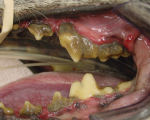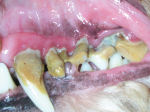Northside Animal Hospital
2317 N. M-52
Owosso, MI 48867
Tel: 989.723.1681
Fax: 989.725.7091
Hours:
M-Th : 8:30am – 5pm
Fri: 8:30am - 4pm
|
 |
Pet Health Library |
This all-in-one source page is where published advice from Northside Animal Hopsital is located on pet health, products, pet care, and 'ask the vet' letters. The library is divided into four main areas:
- Dental Health: Info and Tools
- "Ask the Veterinarian" w/ Dr. Skarich of Northside Animal Hosp.
- Periodontal Disease Stages
- About Periodontal Disease
- Four Steps to Good Dental Care For Dogs
(Note: The files below are all PDF files -
if you need a viewer plugin visit www.adobe.com/products/reader/)
- Weight Watchers for Pets: Info and Tools
Handouts:
- Why Obesity Matters
- Giving Food Treats
- Non-Food Treats
- Exercise: Moving Toward A Healthy Outlook
- Exercise: A Strategy for the Dog with Arthritis
- Pets Age Faster Poster: Learn about your pet's age in years
- 10 Signs of Cat Illness. Sometimes it’s difficult to identify when your cat’s not feeling well.
Watch for these signs of illness.
- 10 Tips for Better Cat Vet Visits. Keeping Cat Veterinary Visits Calmer for Everyone
(Note: The files above are all PDF files -
if you need a viewer plugin visit www.adobe.com/products/reader/)
Forms, pre-surgical and post-surgical information can be found at the forms page.
Dental Health: Info and Tools
“Ask the Veterinarian”
with Dr. Nicholas Skarich of Northside Animal Hospital
Dear Dr. Skarich,
I heard that the majority of dogs have dental disease by the time they’re three-years-old. Is it really that common?
It is estimated that 85% of dogs aged three and older have some degree of periodontal disease, the most common dental disease in dogs.1 And like in humans, periodontal disease is a progressive infection that can lead to painful conditions for dogs and cats, which may require difficult and costly treatments down the road.
Whenever possible, preventing disease is preferable to treating it and in the case of periodontitis, this is especially true. Regular effective home care with daily brushing and early professional cleaning by your veterinarian are among the best preventive measures.
If your pet develops periodontitis, regular professional cleanings and treatment are an important way to help prevent further disease. In addition to causing smelly breath (what you might notice first), periodontal disease can be painful and harmful to your pet’s health.
Dear Dr. Skarich,
Is canine periodontitis really that big of a deal? I mean, I always figured a dog can live a fine life missing a few teeth here and there.
In one word, yes, periodontitis is a big deal, and it can affect more than the dog’s teeth. In fact, the presence of canine periodontitis has been associated with systemic effects in pets and may cause problems in vital organs (heart or liver).2
At its worst, periodontitis can ultimately lead to loss of teeth, fracture of the jawbones, and other serious consequences. A pet’s mouth can be compared to a human’s hand, and its daily function is just as critical. When the mouth isn’t working properly — or hurts — the dog or cat suffers.
Maintaining healthy teeth is critical to keeping a dog healthy and happy.
1 Beard G, Emily P, Mulligan T, Williams C. American Animal Hospital Association, Veterinary Dentistry, Course 1, 1989.
2 DeBowes LJ, Mosier D, Logan E, Harvey CE, Lowry S, Richardson DC. Association of periodontal disease and histologic lesions in multiple organs from 45 dogs. J Vet Dent. 1996;13:57-60.
Periodontal Disease Stages
Periodontal disease, which includes gingivitis and periodontitis, is an inflammation and/or infection of the gums and bone around dog’s teeth. It’s caused by bacteria that accumulate in the mouth, forming soft plaque that later hardens into tartar. If untreated, periodontal disease can eventually lead to tooth loss and serious health problems. Healthy mouths are necessary for healthy and happy pets.
|

Periodontal Disease Stage 1
Stage 1—Gingivitis
Plaque and tarter build-up can lead to an infection causing inflammation of the gums around the dog’s teeth. Gum tissue around the teeth can become inflamed and swollen. |

Periodontal Disease Stage 2
Stage 2—Mild Periodontitis
Inflammation progresses to an infection that starts to destroy gum and bone tissue around the teeth. This can lead to discomfort for the dog, and bad breath may be noticeable. |

Periodontal Disease Stage 3
Stage 3—Moderate Periodontitis
The continuing infection destroys more tissue around the teeth, often causing bleeding of gums and loosening of teeth. The discomfort and pain can affect eating habits and behavior.
|

Periodontal Disease Stage 4
Stage 4—Severe Periodontitis
Extensive infection is tearing down even more of the attachment tissues (gum and bone). Teeth are at risk of being lost. |
About Periodontal Disease
Many pet owners don’t realize that oral disease is the number one health problem diagnosed in pets. In fact, statistics show that 85 percent of all dogs have some sort of tooth and gum disease by the time they are just three-years-old. 1
Just like in humans, dogs are susceptible to plaque and tartar build-up, which can lead to gingivitis and even periodontitis, a chronic form of the disease that can be painful.
Periodontal disease, which includes gingivitis and periodontitis, is an inflammation and/or infection of the gums and bone around dog’s teeth. Over time, plaque and tartar build-up can lead to inflammation of the gums around the dog’s teeth—gingivitis.
Periodontitis is a potentially irreversible infection that if left untreated, can result in the destruction of gum and bone and other tissues around the dog’s teeth. In most severe cases, periodontitis can ultimately lead to loss of teeth, fracture of the jawbones, and other serious consequences that can dramatically impact a dog’s quality of life and overall health.
Whenever it is possible, preventing disease is preferable to treating it and in the case of periodontitis, this is especially true. It is a progressive infectious disease that can lead to unhealthy and painful conditions for dogs that may require difficult and costly treatments.
The good news is that periodontal disease can be prevented with a good dental care program including:
- Daily home oral care
- Regular visits to your veterinarian, which include an oral exam
- Veterinary dental cleaning as advised
Dental diets, oral gels or rinses, and chew toys may also help as aids in prevention.
Keeping your dog’s mouth healthy is essential to their health.
____________________________________________
Beard G, Emily P, Mulligan T, Williams C. American Animal Hospital Association, Veterinary Dentistry, Course 1, 1989. |
Four Steps to Good Dental Care for Dogs
Just like in humans, pet’s teeth need regular attention too. Our busy lives make it challenging to practice effective dental care for our pets, but dental diseases can affect a pet’s overall health. Many pet owners don’t realize that 85% of dogs will have some form of periodontitis by the time they are three-years-old. 1
Thankfully, most dental disease is preventable and by carefully following the simple steps below, that number can dramatically decrease.
STEP 1: Take your pet to the veterinarian for a professional cleaning and scaling. At-home care is essential as well, but only a veterinarian can tackle big issues like plaque and gingivitis.
STEP 2: Implement a regular dental routine at home. There are a number of brushing tools available, from poultry favored toothpaste to toothbrushes that fit right on your fingertip. We also recommend a number of other products, including pet mouth rinses.
STEP 3: Schedule regular veterinary check-ups which include an oral exam. Regular visits to the veterinarian are critical to your pet’s overall health.
STEP 4: Discuss with your veterinarian the best chew toys for your pet. They may also recommend a dental diet that may help as aids in prevention of periodontitis.
1 Beard G, Emily P, Mulligan T, Williams C. American Animal Hospital Association, Veterinary Dentistry, Course 1, 1989.
|
| |
|
|
| |
|
We provide care for your dogs, puppies, cats, kittens, ferrets, rabbits, rats, mice, sugar gliders, hedgehogs, hamsters, guinea pigs, gerbils, snakes, lizards, geckos, turtles, tortoises and more!
Website home of Northside Animal Hospital PC, Owosso, MI. Listed under vets, veterinary services, vet practices, animal clinics, veterinarians in Owosso, Michigan and near Owosso, Michigan. Serving Owosso, Corunna, Bancroft, Durand, Elsie, Henderson, Laingsburg, Ovid, Perry, Vernon, and all of greater Shiawassee County.
|





